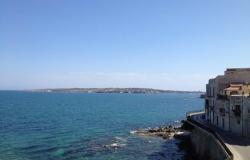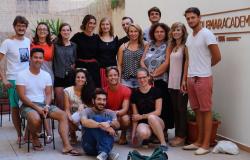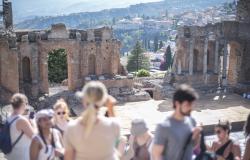Today I want to share with you some of my favourite reading about Sicily. These are not travel guides but well-written, informative works by people who have made their homes here - people whose love for the island shines through in every word they write. I think these books could also be of interest to any lover of Italy in general.
1. A House in Sicily
 The first book is “A House in Sicily” by Daphne Phelps. In 1947 Phelps inherited the beautiful Casa Cuseni in Taormina and came to the island from Britain to inspect the house with a view to selling it. However, she surprised herself by deciding to stay and maintain it. She had to struggle to hold on to the house in the early days and anyone who has moved here will identify with her brushes with Italian bureaucracy.
The first book is “A House in Sicily” by Daphne Phelps. In 1947 Phelps inherited the beautiful Casa Cuseni in Taormina and came to the island from Britain to inspect the house with a view to selling it. However, she surprised herself by deciding to stay and maintain it. She had to struggle to hold on to the house in the early days and anyone who has moved here will identify with her brushes with Italian bureaucracy.
Phelps tells us of the ups and downs of running the property, the characters who work for her and the townsfolk she meets. She regales us with tales of some of the people she entertained at Casa Cuseni, among them the philosopher Bertrand Russell, the author Roald Dahl and Caitlin Thomas, widow of the Welsh poet Dylan Thomas and not an easy guest. As we read, we get to know Phelps and observe her falling in love with Sicily. There is also an hilarious chapter detailing her encounters with the head of the local Mafia. Daphne Phelps died in 2005 at the age of 94. Sadly, Phelps’s nephews and nieces are not now in a position to maintain the house and have offered it for sale.
A House in Sicily on Amazon US.
A House in Sicily on Amazon UK.
2. Sicilian Food
 Mary Taylor Simeti is the author of “Sicilian Food”, probably still the most authoritative work available on the subject in English. My own copy is well-thumbed . But she is also the author of another favourite of mine: this is “On Persephone’s Island”, a journal which takes us through the seasons in Sicily. Simeti brings to life the scenery, festivals and history of Sicily. Of the Italian – and particularly Sicilian – love of festivals she writes:
Mary Taylor Simeti is the author of “Sicilian Food”, probably still the most authoritative work available on the subject in English. My own copy is well-thumbed . But she is also the author of another favourite of mine: this is “On Persephone’s Island”, a journal which takes us through the seasons in Sicily. Simeti brings to life the scenery, festivals and history of Sicily. Of the Italian – and particularly Sicilian – love of festivals she writes:
“To eat all one wants and more, in one glorious and wasteful feed, is to consecrate the feast day by distinguishing it from the careful measuring out of the daily bread.”
Sicilian Food on Amazon US.
Sicilian Food on Amazon UK.
3. On Persephone's Island
 Like me, Mary Taylor Simeti is fascinated by the myth of Persephone, according to which Persephone [Core / Kora], daughter of Zeus and Demeter [Ceres], was abducted by Hades [Aidoneus / Pluto] whilst gathering flowers at Enna. [Well, the Sicilians – and I – believe it was Enna. It could have been almost anywhere in the Greek world.] Demeter's grief for her daughter knew no bounds and she wandered the earth trying to find her, neglecting her duties as goddess of corn and so causing a worldwide famine. Zeus, forced to intervene, persuaded Hades to allow Persephone to return from the underworld, but she was tricked into eating some pomegranate seeds, the "food of the dead". This precluded Persephone's return to earth. Sources vary in their accounts of how many seeds she ate - Homer says one, Graves seven, Tennyson assumes three, other sources six - but it was agreed that Persephone would spend a month with Hades for each one. Let us believe, for the sake of the story, that it was three or four. Thus Persephone spends the winter months with her husband and returns to earth and Demeter for the spring. With her comes rain for the crops and that is why Sicily remains fertile. For Persephone [lucky girl] had received Sicily as a wedding present, so it is only fitting that she should take special care of it.
Like me, Mary Taylor Simeti is fascinated by the myth of Persephone, according to which Persephone [Core / Kora], daughter of Zeus and Demeter [Ceres], was abducted by Hades [Aidoneus / Pluto] whilst gathering flowers at Enna. [Well, the Sicilians – and I – believe it was Enna. It could have been almost anywhere in the Greek world.] Demeter's grief for her daughter knew no bounds and she wandered the earth trying to find her, neglecting her duties as goddess of corn and so causing a worldwide famine. Zeus, forced to intervene, persuaded Hades to allow Persephone to return from the underworld, but she was tricked into eating some pomegranate seeds, the "food of the dead". This precluded Persephone's return to earth. Sources vary in their accounts of how many seeds she ate - Homer says one, Graves seven, Tennyson assumes three, other sources six - but it was agreed that Persephone would spend a month with Hades for each one. Let us believe, for the sake of the story, that it was three or four. Thus Persephone spends the winter months with her husband and returns to earth and Demeter for the spring. With her comes rain for the crops and that is why Sicily remains fertile. For Persephone [lucky girl] had received Sicily as a wedding present, so it is only fitting that she should take special care of it.
Simeti feels Persephone’s presence in her everyday life and I have come to understand this over the past five years. Whenever we have torrential rain in spring, I find myself saying, “It’s Persephone’s weather”. Simeti writes:
“Perhaps it was my growing interest in calendars: the story of Persephone’s descent into the Underworld each winter and her return four months later was perhaps the earliest attempt to divide the year into seasons and to explain its rhythms.”
This is a book that I have read three times to date and I love it because it reminds me why I came here.
On Persephone's Island on Amazon US.
On Persephone's Island on Amazon UK.
4. Travels with a Medieval Queen
 Recently I read another Simeti, a very different book entitled “Travels with a Medieval Queen”: In 1185 Constance d’Hauteville, daughter of Roger II of Sicily and heiress to the Sicilian throne in her own right, set out, with her entourage and the richest dowry ever seen in Europe, for Germany where she was to be married to Henry, son of Frederick Barbarossa.
Recently I read another Simeti, a very different book entitled “Travels with a Medieval Queen”: In 1185 Constance d’Hauteville, daughter of Roger II of Sicily and heiress to the Sicilian throne in her own right, set out, with her entourage and the richest dowry ever seen in Europe, for Germany where she was to be married to Henry, son of Frederick Barbarossa.
The book tells the story of Simeti’s attempt to retrace Constance’s year-long last journey home to Sicily in 1195. Aged 40 at the time and childless, Constance discovered, en route, that she was pregnant and gave birth – publicly - to the future Frederick II in Jesi [Ancona].
Much of the book is conjecture, as Simeti freely admits, for very little was documented about this journey. I must admit that sometimes, in my reading, I felt I was being bumped along slowly in a litter, like Constance. Yet here and there Simeti gives us fascinating glimpses of the medieval world Simeti is well aware of the dangers of interpreting a medieval character through modern eyes and among the questions which she raises are: Was there any concept of “self”, as post-Renaissance man understands it? How attached were mothers to their children? Were they afraid to love them because the infant mortality rate was so high? How was colour perceived? It was, Simeti says, an “urban phenomenon” and mostly available only to the rich, as dyes were expensive. Ordinary folk saw bright colours only in church. How did Constance feel in the muted light of Germany after being brought up in the magnificence of Palermo? And how did she feel as the landscape changed as she reached the south once more? I have become much more aware of this change in vegetation between north and south since reading the book.
I was particularly interested in the way that Constance's status changed once the precious heir was born for even today, childless women are often made to feel , if not inferior, “different”. I came to rather like Constance and am glad that Dante puts her in Paradise:
Quest'è la luce de la gran Costanza
che del secondo vento di Soave
generò 'l terzo e l'ultima possanza.
This is the splendour of the great Constance
who from the Swabians' second gust engendered
the one who was their third and final power.
Paradiso, Canto III, 118 -120.
Constance is buried in Palermo Cathedral. Next time I am there I will do what Simeti has vowed to do: I will leave some flowers for the Empress.
Travels with a Medieval Queen on Amazon US.
Travels with a Medieval Queen on Amazon UK.
Bitter Almonds
 If you were interested in our article about food shopping in less crowded locations, you may like to know that Maria Grammatico of the Pasticceria Grammatico in Erice [Sicily] has told her story to Mary Taylor Simeti. Together they wrote the book, “Bitter Almonds”.
If you were interested in our article about food shopping in less crowded locations, you may like to know that Maria Grammatico of the Pasticceria Grammatico in Erice [Sicily] has told her story to Mary Taylor Simeti. Together they wrote the book, “Bitter Almonds”.
Bitter Almonds on Amazon US.
Bitter Almonds on Amazon UK.








